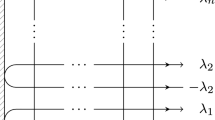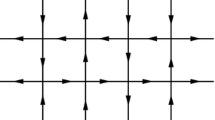Abstract
We introduce and study a class of partition functions of an elliptic free-fermionic face model. We study the partition functions with a triangular boundary using the off-diagonal K-matrix at the boundary (OS boundary), which was introduced by Kuperberg as a class of variants of the domain wall boundary partition functions. We find explicit forms of the partition functions with OS boundary using elliptic Pfaffians. We find two expressions based on two versions of Korepin’s method, and we obtain an identity between two elliptic Pfaffians as a corollary.








Similar content being viewed by others
References
Bethe, H.: On the theory of metals. I. Eigenvalues and eigenfunctions of a linear chain of atoms. Z. Phys. 71, 205–226 (1931)
Faddeev, L.D., Sklyanin, E.K., Takhtajan, L.A.: Quantum inverse problem method I. Theor. Math. Phys. 40, 194–220 (1979)
Baxter, R.J.: Exactly Solved Models in Statistical Mechanics. Academic Press, London (1982)
Korepin, V.B., Bogoliubov, N.M., Izergin, A.G.: Quantum Inverse Scattering Method and Correlation Functions. Cambridge University Press, Cambridge (1993)
Jimbo, M., Miwa, T.: Algebraic Analysis of Solvable Lattice Models. American Mathematical Society, Providence (1995)
Reshetikhin, N.: Lectures on integrable models in statistical mechanics. In: Exact Methods in Low- Dimensional Statistical Physics and Quantum Computing, Proceedings of Les Houches School in Theoretical Physics. Oxford University Press (2010)
Korepin, V.E.: Calculation of norms of Bethe wave functions. Commun. Math. Phys. 86, 391–418 (1982)
Izergin, A.: Partition function of the six-vertex model in a finite volume. Sov. Phys. Dokl. 32, 878–879 (1987)
Tsuchiya, O.: Determinant formula for the six-vertex model with reflecting end. J. Math. Phys. 39, 5946–5951 (1998)
Bressoud, D.: Proofs and Confirmations: The Story of the Alternating Sign Matrix Conjecture. MAA Spectrum, Mathematical Association of America, Washington, DC (1999)
Kuperberg, G.: Another proof of the alternating-sign matrix conjecture. Int. Math. Res. Not. 3, 139–150 (1996)
Kuperberg, G.: Symmetry classes of alternating-sign matrices under one roof. Ann. Math. 156, 835–866 (2002)
Okada, S.: Enumeration of symmetry classes of alternating sign matrices and characters of classical groups. J. Algebr. Comb. 23, 43–69 (2001)
Razumov, A.V., Stroganov, Y.G.: On refined enumerations of some symmetry classes of ASMs. Theor. Math. Phys. 141, 1609–1630 (2004)
Colomo, F., Pronko, A.G.: Square ice, alternating sign matrices, and classical orthogonal polynomials. J. Stat. Mech.: Theor. Exp. 2005, P01005 (2005)
Betea, D., Wheeler, M., Zinn-Justin, P.: Refined Cauchy/Littlewood identities and six-vertex model partition functions: II. Proofs and new conjectures. J. Algebr. Comb. 42, 555–603 (2015)
Behrend, R.E., Fischer, I., Konvalinka, M.: Diagonally and antidiagonally symmetric alternating sign matrices of odd order. Adv. Math. 315, 324–365 (2017)
Okada, S.: Alternating sign matrices and some deformations of Weyl’s denominator formula. J. Algebr. Comb. 2, 155–176 (1993)
Hamel, A., King, R.C.: Symplectic shifted tableaux and deformations of Weyl’s denominator formula for \(sp(2n)\). J. Algebr. Comb. 16, 269–300 (2002)
Hamel, A., King, R.C.: U-turn alternating sign matrices, symplectic shifted tableaux and their weighted enumeration. J. Algebr. Comb. 21, 395–421 (2005)
Zhao, S.-Y., Zhang, Y.-Z.: Supersymmetric vertex models with domain wall boundary conditions. J. Math. Phys. 48, 023504 (2007)
Foda, O., Caradoc A., Wheeler, M., Zuparic, M.: On the trigonometric Felderhof model with domain wall boundary conditions. J. Stat. Mech. 2007, P03010 (2007)
Foda, O., Wheeler, M., Zuparic, M.: Two elliptic height models with factorized domain wall partition functions J. Stat. Mech. 2008, P02001 (2008)
Zuparic, M.: Studies in integrable quantum lattice models and classical hierarchies, PhD thesis, Department of Mathematics and Statistics, University of Melbourne (2009). e-print arXiv:0908.3936 [math-ph]
Wheeler, M.: Free fermions in classical and quantum integrable models, PhD Thesis, Department of Mathematics and Statistics, University of Melbourne (2010). e-print arXiv:1110.6703 [math-ph]
Brubaker, B., Schultz, A.: The 6-vertex model and deformations of the Weyl character formula. J. Algebr. Comb. 42, 917–958 (2015)
Rosengren, H.: Elliptic Pfaffians and solvable lattice models. J. Stat. Mech. 2016, P083106 (2016)
Andrews, G.E., Baxter, R.J., Forrester, P.J.: Eight-vertex SOS model and generalized Rogers–Ramanujan-type identities. J. Stat. Phys. 35, 193–266 (1984)
Rosengren, H.: An Izergin–Korepin-type identity for the 8VSOS model, with applications to alternating sign matrices. Adv. Appl. Math. 43, 137–155 (2009)
Pakuliak, S., Rubtsov, V., Silantyev, A.: The SOS model partition function and the elliptic weight functions. J. Phys. A: Math. Theor. 41, 295204 (2008)
Yang, W.-L., Zhang, Y.-Z.: Partition function of the eight-vertex model with domain wall boundary condition. J. Math. Phys. 50, 083518 (2009)
Galleas, W.: Elliptic solid-on-solid model’s partition function as a single determinant. Phys. Rev. E 94, 010102(R) (2016)
Okada, S.: An elliptic generalization of Schur’s Pfaffian identity. Adv. Math. 204, 530–538 (2006)
Rosengren, H.: Sums of triangular numbers from the Frobenius determinant. Adv. Math. 208, 935–961 (2007)
Rosengren, H.: Sums of squares from elliptic pfaffians. Int. J. Number Theory 4, 873–902 (2008)
Rains, E.: Recurrences for elliptic hypergeometric integrals. Rokko lectures in mathematics. Elliptic Integr. Syst. 18, 183–199 (2005)
Schur, I.: Uber die Darstellung der symmetrischen und der alternirenden Gruppe durch gebrochene lineare Substitutuionen. J. Reine Angew. Math. 139, 155–250 (1911)
Cauchy, A.L.: Memoire sur les fonctions alternees et sur les sommes alternees. Exercices Anal. et Phys. Math. 2, 151–159 (1841)
Frobenius, F.: Uber die elliptischen Funktionen zweiter Art. J. fur die reine und ungew. Math. 93, 53–68 (1882)
Hasegawa, K.: Ruijsenaars’ commuting difference operators as commuting transfer matrices. Commun. Math. Phys. 187, 289–325 (1997)
Warnaar, O.: Summation and transformation formulas for elliptic hypergeometric series. Constr. Approx. 18, 479–502 (2002)
Rosengren, H., Schlosser, M.: Elliptic determinant evaluations and the Macdonald identities for affine root systems. Comput. Math. 142, 937–961 (2006)
Okado, M.: Solvable face models related to the Lie superalgebra \(sl(m|n)\). Lett. Math. Phys. 22, 39–43 (1991)
Deguchi, T., Martin, P.: An algebraic approach to vertex models and transfer matrix spectra. Int. J. Mod. Phys. A 7(Suppl. 1A), 165–196 (1992)
Baxter, R.J.: Partition function of the eight-vertex lattice model. Ann. Phys. (NY) 70, 193–228 (1972)
Felderhof, B.: Direct diagonalization of the transfer matrix of the zero-field free-fermion model. Physica 65, 421–451 (1973)
Drinfeld, V.: Hopf algebras and the quantum Yang–Baxter equation. Sov. Math. Dokl. 32, 254–258 (1985)
Jimbo, M.: A \(q\)-difference analogue of \(U(G)\) and the Yang–Baxter equation. Lett. Math. Phys. 10, 63–69 (1985)
Lieb, E.H., Wu, F.Y.: Two-dimensional ferroelectric models. In: Phase Transitions and Critical Phenomena, vol. 1, pp. 331–490. Academic Press, London (1972)
Perk, J.H.H., Schultz, C.L.: New families of commuting transfer matrices in q-state vertex models. Phys. Lett. A 84, 407–410 (1981)
Murakami, J.: The free-fermion model in presence of field related to the quantum group \(U_q(sl_2)\) of affine type and the multi-variable Alexander polynomial of links. Infinite analysis. Adv. Ser. Math. Phys. 16B, 765–772 (1991)
Deguchi, T., Akutsu, Y.: Colored vertex models, colored IRF models and invariants of trivalent colored graphs. J. Phys. Soc. Jpn. 62, 19–35 (1993)
Wheeler, M.: An Izergin–Korepin procedure for calculating scalar products in six-. the vertex model. Nucl. Phys. B 852, 469–507 (2011)
Filali, G., Kitanine, N.: The partition function of the trigonometric SOS model with a reflecting end. J. Stat. Mech. 2010, L01001(2010)
Filali, G.: Elliptic dynamical reflection algebra and partition function of SOS model with reflecting end. J. Geom. Phys. 61, 1789–1796 (2011)
Yang, W.-L., Chen, X., Feng, J., Hao, K., Shi, K.-J., Sun, C.-Y., Yang, Z.-Y., Zhang, Y.-Z.: Domain wall partition function of the eight-vertex model with a non-diagonal reflecting end. Nucl. Phys. B 847, 367–386 (2011)
Yang, W.-L., Chen, X., Feng, J., Hao, K., Wu, K., Yang, Z.-Y., Zhang, Y.-Z.: Scalar products of the open XYZ chain with non-diagonal boundary terms. Nucl. Phys. B 848, 523–544 (2011)
Galleas, W.: Multiple integral representation for the trigonometric SOS model with domain wall boundaries. Nucl. Phys. B 858, 117–141 (2012)
Galleas, W.: Refined functional relations for the elliptic SOS model. Nucl. Phys. B 867, 855–871 (2013)
Galleas, W., Lamers, J.: Reflection algebra and functional equations. Nucl. Phys. B 886, 1003–1028 (2014)
Lamers, J.: Integral formula for elliptic SOS models with domain walls and a reflecting end. Nucl. Phys. B 901, 556–583 (2015)
Motegi, K.: Elliptic supersymmetric integrable model and multivariable elliptic functions. Prog. Theor. Exp. Phys. 2017, 123A01 (2017)
Motegi, K.: Symmetric functions and wavefunctions of XXZ-type six-vertex models and elliptic Felderhof models by Izergin–Korepin analysis. J. Math. Phys. 59, 053505 (2018)
Motegi, K.: Scalar products of the elliptic Felderhof model and elliptic Cauchy formula. J. Geom. Phys. 134, 58–76 (2018)
Felder, G., A. Schorr, A.: Separation of variables for quantum integrable systems on elliptic curves. J. Phys. A: Math. Gen. 32, 8001 (1999)
Felder, G.: Elliptic quantum groups. In: Proceedings of the XIth International Congress of Mathematical Physics (Paris, 1994), pp. 211–218. International Press, Boston (1995)
Felder, G., Varchenko, A.: Algebraic Bethe ansatz for the elliptic quantum group \(E_{\tau,\eta }(sl_2)\). Nucl. Phys. B 480, 485–503 (1996)
Sklyanin, E.K.: Boundary conditions for integrable quantum systems. J. Phys. A 21, 2375–2398 (1988)
de Vega, H.J., Gonzalez-Ruiz, A.: Boundary K-matrices for the XYZ, XXZ and XXX spin chains. J. Phys. A 27, 6129–6137 (1994)
Inami, T., Konno, H.: Integrable XYZ spin chain with boundaries. J. Phys. A 27, L913–L918 (1994)
Fan, H., Hou, B.-Y., Shi, K.-J.: General solution of reflection equation for eight-vertex SOS model. J. Phys. A: Math. Gen. 28, 4743 (1995)
Behrend, R.E., Pearce, P.: A construction of solutions to reflection equations for interaction-round-a-face models. J. Phys. A: Math. Gen. 29, 7827 (1996)
Schorr, A.: Separation of variables for the eight-vertex SOS model with antiperiodic boundary conditions. Diss. Mathematische Wissenschaften ETH Zurich, Nr. 13682 (2000)
Acknowledgements
The author thanks the referees for careful reading, various invaluable comments and suggestions to improve the paper. This work was partially supported by Grant-in-Aid for Scientific Research (C) No. 18K03205 and No. 16K05468.
Author information
Authors and Affiliations
Corresponding author
Appendix: An elementary proof of (4.35) for the case \(n=2\)
Appendix: An elementary proof of (4.35) for the case \(n=2\)
In this Appendix, we check (4.35) for the case \(n=2\) by elementary manipulations. In this case, one can see from the definition of Pfaffians (2.1) that proving (4.35) is equivalent to showing the following identity
Let us show this using the addition formula for theta functions (2.8) repeatedly. The difference between the left hand side and the right-hand side of (A.1) can be expressed as
Using the addition formula for theta functions (2.8) (and (2.7)), one finds
Using identities (A.3), (A.4) and (A.5), (A.2) reduces to
One can apply addition formula (2.8) again to get
and we find the right-hand side of (A.6) becomes zero. Hence (4.35) for the case \(n=2\) is proved.
Rights and permissions
About this article
Cite this article
Motegi, K. Elliptic free-fermion model with OS boundary and elliptic Pfaffians. Lett Math Phys 109, 923–943 (2019). https://doi.org/10.1007/s11005-018-1130-8
Received:
Revised:
Accepted:
Published:
Issue Date:
DOI: https://doi.org/10.1007/s11005-018-1130-8




